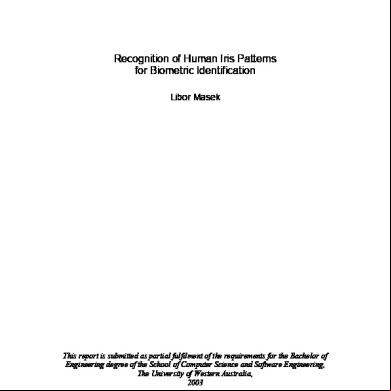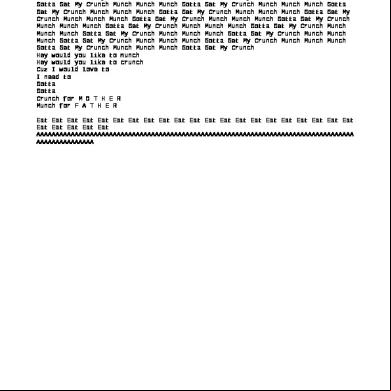General Ppt - Iris Recognition System-march 4e3mt
This document was ed by and they confirmed that they have the permission to share it. If you are author or own the copyright of this book, please report to us by using this report form. Report 3i3n4
Overview 26281t
& View General Ppt - Iris Recognition System-march as PDF for free.
More details 6y5l6z
- Words: 768
- Pages: 16
A General Presentation on IRIS RECOGNITION SYSTEM SUBMITTED BY NAGANABOINA KRISHNAVENI Reg. No: 24917080 Dept of Computer Science
SHRI JAGDISH PRASAD JHABARMAL TIBREWALA UNIVERSITY, JHUNJHUNU, RAJASTHAN
Introduction Iris recognition is a method of biometric identification and authentication that use patternrecognition techniques based on high resolution images of the irises of an individual's eyes .
It is considered to be the most accurate biometric technology available today.
What is Iris ? The colored ring around the pupil of the eye is called the Iris
What is Iris ? The iris is a thin circular diaphragm, which lies between the cornea and the lens of the human eye. The iris is perforated close to its centre by a circular aperture known as the pupil. The function of the iris is to control the amount of light entering through the pupil.
The average diameter of the iris is 12 mm, and the pupil size can vary from 10% to 80% of the iris diameter [2].
What is Iris ?
The iris consists of a number of layers, the lowest is the epithelium layer, which contains dense pigmentation cells. The stromal layer lies above the epithelium layer, and
contains blood vessels, pigment cells and the two iris muscles.
What is Iris ? The
density of stromal pigmentation determines the colour of the iris.
The externally visible surface of the multilayered iris contains two zones, which often differ in colour An outer ciliary zone and an inner pupillary zone, and these two zones are divided by the collarette – which appears as a zigzag pattern[3].
Why the Iris?
Externally visible highly protected internal organ.
Unique patterns of Iris are not allowed to genetic factors.
Twins also don’t have same pattern.
Not genetically connected unlike eye color.
It is Stable throughout the life.
Impossible to alter surgically.
It is Living , it Can not be forgotten or copied or changed.
It Works on blind person.
no need to touch appliances.
Accurate , faster , and s large data base.
Why the Iris?
History of Iris Recognition The concept of Iris Recognition was first proposed by Dr. Frank Burch in 1939. 1980
It was first implemented in 1990 1987when Dr. John Daugman created the algorithms for it. 1987These algorithms employ methods of
pattern recognition and some mathematical calculations for iris 1997-1999 recognition.
Applications ATMs .Computer : The iris as a living . · National Border Controls · Driving licenses and other personal certificates. · benefits authentication. ·birth certificates, tracking missing. · Credit-card authentication. · Anti-terrorism (e.g.:— suspect Screening at airports) · Secure financial transaction (ecommerce, banking). · Internet security, control of access to privileged information.
Methods Of IRIS Recognition System
In identifying one’s iris, there are 2 methods for its
recognition and are: 1. Active 2. ive
The active Iris system requires that a be
anywhere from six to fourteen inches away from the camera. The ive system allows the to be
anywhere from one to three feet away from the camera that locates the focus on the iris.
Iris Recognition Diagram Iris Segmentation
Image Acquisition Eye Image
Normalization Iris Region Feature points in the iris region
Identify or Reject Subject
Feature Matching
Feature Encoding
Iris Template
Iris Templates Database
Advantages: It is an internal organ that is well protected against damaged. There is no need for the person being identified to touch any equipment. Iris recognition works with clear lenses, eyeglasses.
Disadvantages
Accuracy changes with ’s height ,illumination , Image quality etc. Person needs to be still, difficult to scan if not cooperated. Alcohol consumption causes deformation in Iris pattern Expensive .
Conclusion
Highly accurate but easy Fast Needs some developments Experiments are going on Will become day to day technology very soon
References
[1] · http://www.cl.cam.ac.uk
[2] J. Daugman. How iris recognition works. Proceedings of 2002 International Conference on Image Processing,Vol. 1, 2002.
[3]E. Wolff. Anatomy of the Eye and Orbit. 7th edition. H. K. Lewis & Co. LTD, 1976.
[4] L.Flom and A. Safir : Iris Recognition System .U.S. atent No.4641394(1987).
[5] T. Chuan Chen K . Liang Chung : An Efficient Randomized Algorithm for Detecting Circles. Computer vision and Image Understanding Vol.83(2001) 172-191.
[6] Amel saeed Tuama “ It is Image Segmentation and Recognition Technology” vol-3 No.2 April 2012 .
[7] S. Sanderson, J. Erbetta. Authentication for secure environments based on iris scanning technology. IEE Colloquium on Visual Biometrics, 2000 .
SHRI JAGDISH PRASAD JHABARMAL TIBREWALA UNIVERSITY, JHUNJHUNU, RAJASTHAN
Introduction Iris recognition is a method of biometric identification and authentication that use patternrecognition techniques based on high resolution images of the irises of an individual's eyes .
It is considered to be the most accurate biometric technology available today.
What is Iris ? The colored ring around the pupil of the eye is called the Iris
What is Iris ? The iris is a thin circular diaphragm, which lies between the cornea and the lens of the human eye. The iris is perforated close to its centre by a circular aperture known as the pupil. The function of the iris is to control the amount of light entering through the pupil.
The average diameter of the iris is 12 mm, and the pupil size can vary from 10% to 80% of the iris diameter [2].
What is Iris ?
The iris consists of a number of layers, the lowest is the epithelium layer, which contains dense pigmentation cells. The stromal layer lies above the epithelium layer, and
contains blood vessels, pigment cells and the two iris muscles.
What is Iris ? The
density of stromal pigmentation determines the colour of the iris.
The externally visible surface of the multilayered iris contains two zones, which often differ in colour An outer ciliary zone and an inner pupillary zone, and these two zones are divided by the collarette – which appears as a zigzag pattern[3].
Why the Iris?
Externally visible highly protected internal organ.
Unique patterns of Iris are not allowed to genetic factors.
Twins also don’t have same pattern.
Not genetically connected unlike eye color.
It is Stable throughout the life.
Impossible to alter surgically.
It is Living , it Can not be forgotten or copied or changed.
It Works on blind person.
no need to touch appliances.
Accurate , faster , and s large data base.
Why the Iris?
History of Iris Recognition The concept of Iris Recognition was first proposed by Dr. Frank Burch in 1939. 1980
It was first implemented in 1990 1987when Dr. John Daugman created the algorithms for it. 1987These algorithms employ methods of
pattern recognition and some mathematical calculations for iris 1997-1999 recognition.
Applications ATMs .Computer : The iris as a living . · National Border Controls · Driving licenses and other personal certificates. · benefits authentication. ·birth certificates, tracking missing. · Credit-card authentication. · Anti-terrorism (e.g.:— suspect Screening at airports) · Secure financial transaction (ecommerce, banking). · Internet security, control of access to privileged information.
Methods Of IRIS Recognition System
In identifying one’s iris, there are 2 methods for its
recognition and are: 1. Active 2. ive
The active Iris system requires that a be
anywhere from six to fourteen inches away from the camera. The ive system allows the to be
anywhere from one to three feet away from the camera that locates the focus on the iris.
Iris Recognition Diagram Iris Segmentation
Image Acquisition Eye Image
Normalization Iris Region Feature points in the iris region
Identify or Reject Subject
Feature Matching
Feature Encoding
Iris Template
Iris Templates Database
Advantages: It is an internal organ that is well protected against damaged. There is no need for the person being identified to touch any equipment. Iris recognition works with clear lenses, eyeglasses.
Disadvantages
Accuracy changes with ’s height ,illumination , Image quality etc. Person needs to be still, difficult to scan if not cooperated. Alcohol consumption causes deformation in Iris pattern Expensive .
Conclusion
Highly accurate but easy Fast Needs some developments Experiments are going on Will become day to day technology very soon
References
[1] · http://www.cl.cam.ac.uk
[2] J. Daugman. How iris recognition works. Proceedings of 2002 International Conference on Image Processing,Vol. 1, 2002.
[3]E. Wolff. Anatomy of the Eye and Orbit. 7th edition. H. K. Lewis & Co. LTD, 1976.
[4] L.Flom and A. Safir : Iris Recognition System .U.S. atent No.4641394(1987).
[5] T. Chuan Chen K . Liang Chung : An Efficient Randomized Algorithm for Detecting Circles. Computer vision and Image Understanding Vol.83(2001) 172-191.
[6] Amel saeed Tuama “ It is Image Segmentation and Recognition Technology” vol-3 No.2 April 2012 .
[7] S. Sanderson, J. Erbetta. Authentication for secure environments based on iris scanning technology. IEE Colloquium on Visual Biometrics, 2000 .










